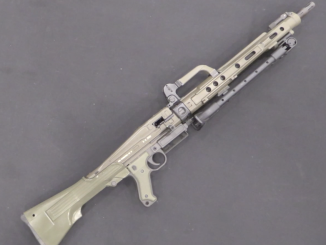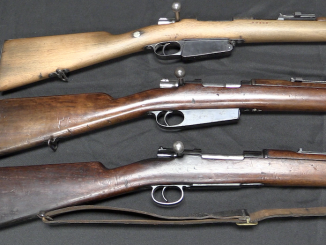Star introduced their first compact tilting-barrel pistol (the Model D) in 1922. The Spanish military was interested in something along these lines, but the Model D was intended to be a civilian pocket-carry gun, and was just too small for military use. What was needed was something still compact, but with a full-size grip – a gun that could serve as a pilot’s emergency pistol, for instance. Star developed this as the Model S, still chambered for the .380ACP cartridge, but with an 8-round capacity.
The Model S was introduced in 1935, but the Spanish Civil War the next year prevented production from really beginning until 1939. The Model S at that point does get a lot of Spanish military and police interest, including a contract from the Spanish Air Force, which this pistol is an example of (manufactured in 1945). They were purchased by a number of foreign militaries as well, and served with Spanish police forces into the 1990s – despite most people thinking they were just a civilian pistol.




http://www.star-firearms.com/firearms/guns/s/index.shtml claims that S was so similar to A and B that manufacturer shipped with same manual. Was that also done by U.S. importers or they provided different manuals?
Interestingly since 1948 link-less version (Super-S) was produced alongside original one.
The Star S was designed after the Spanish Civil War, in 1940, and was adopted in 1941 as the regulation pistol of the Spanish National Police (Policía Armada y de Tráfico). The Guardia Civil had used since 1922 the Star model A in 9 mm largo, replaced in the late 1970s by the 9 mm Parabellum’s Star BM.
In the 1940s the Star S was also adopted by the newly created Spanish Air Force to arm the pilots who needed a smaller pistol than the Star A or Astra 400, used by the aviation land troops.
The Star S was used by the Spanish National Police until the late 1970s, when it was substituted (briefly) in the by the Astra 960 38 sp. revolver and later by the excellent 9 mm Parabellum Star mod. 30 in 1982.
It seems like a neat gun, even if breechlock .380 ACP is kinda overkill.
Well you can make the overall gun lighter, when using a locked breach for.380 instead of relying on inertia inva blowback system. Resulting in a smaller lighter gun that is safer and could also shoot hotter loads if needed. Only dwnside is complexity and thus cost.
Small compact locked breach pistols in .380seem to become fashionable again today. And IMHO they have a place in the market for concealed carry and people not strong enough for a full power full size 9*19 mm pistol. One size does not fit all after all.
On the other hand, as long as you are using metal frame, standard slide setup and a not super-short barrel, you can’t really make a .380 ACP gun lighter by making it locked breech. Because the weight of the slide and frame needed to mot make it flimsy, is enough to lock the breech also.
That’s why the 9mm Browning Long / 9mm Glisenti / 9mm Ultra / 9mm Makarov are considered “the hottest calibers you can shoot in a blowback handgun”. They are not, obviously. You can shoot any caliber in a blowback gun with a heavy enough bolt. It’s implied “without weight disadvantages”.
Can anyone advise what the “bomb” rollmark stamp, means, on a Star pistol. I own a .40 cal Starfire, manufactured un 1991 (K2). Under the left grip, there is a “bomb”, above the K2, which makes me think it is a military acceptance stamp??